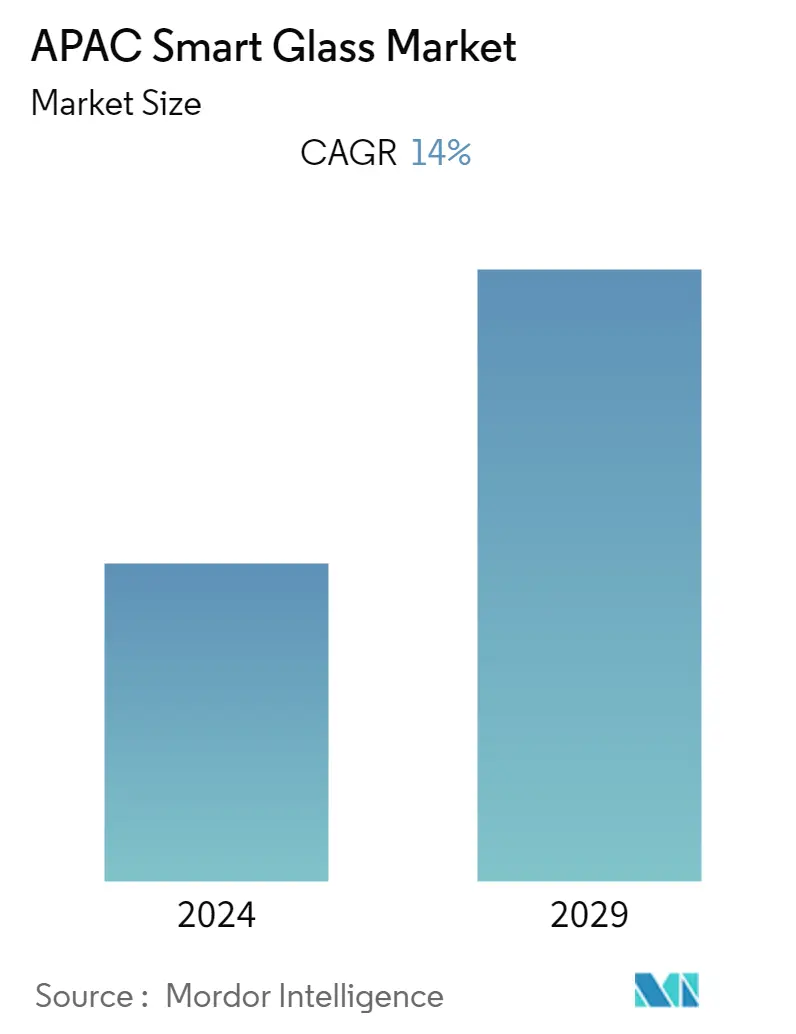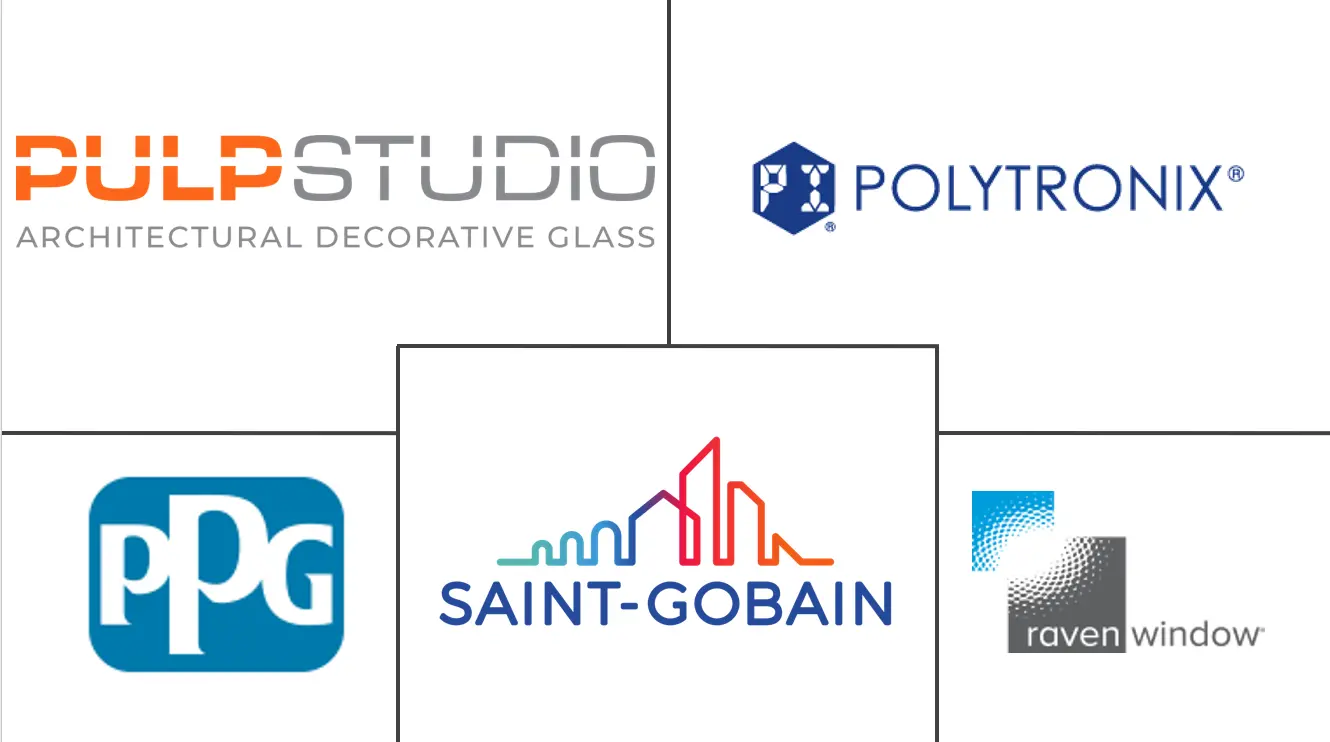Market Size of APAC Smart Glass Industry

| Study Period | 2019 - 2029 |
| Base Year For Estimation | 2023 |
| Forecast Data Period | 2024 - 2029 |
| Historical Data Period | 2019 - 2022 |
| CAGR | 14.00 % |
| Market Concentration | Low |
Major Players
*Disclaimer: Major Players sorted in no particular order |
APAC Smart Glass Market Analysis
Asia Pacific smart glass market is estimated to grow at a CAGR of 14% in the forecasted period (2021-2026). The market has been gaining significant traction due to the surging demand for energy cost savings in high-end commercial offices and residential spaces in the Asia Pacific. However, the COVID-19 pandemic has significantly affected the construction activities of the residential and commercial buildings in 2020, resulting in delayed building construction projects or halted for the short term.
With a growing focus on sustainable development, an increasing number of people have been opting for user-controlled windows in buildings. Smart glass manufacturers have been actively investing in research and development to cut production costs by implementing newer technologies and low-cost raw materials.
There has been a great amount of research and development going on in the region on smart glasses. For instance, in recent years, researchers at Shanghai University have designed the first smart window, which can produce electricity. The window acts like a solar panel and uses Vanadium dioxide film to produce electricity. Such developments are expected to provide further growth opportunities to the market, especially in offices, residential homes, and hotels.
Also, Scientists at the Nanyang Technological University, one of Singapore's engineering research institutes, have developed a unique liquid window panel that can block sunlight to regulate solar transmission into a room. Besides this, the panel can simultaneously trap thermal heat received from sunlight, gradually release it later, and help regulate indoor temperature.
The majority of the smart glass growth in the region is expected to be observed in the building sector, taking advantage of the significant cost savings and energy efficiency. Employees and residents are looking forward to benefiting from the increased natural light and access to views of the outdoors, which can improve both their health and productivity.
However, due to the pandemic, construction projects' demand has fallen due to poor business sentiments, lower operating surpluses and incomes, diversion of funds for COVID-19 management, and liquidity problems. There has been a decrease in construction activities and supply chain disruptions that have resulted in projects being delayed or halted for the short term, restraining the market's growth.
APAC Smart Glass Industry Segmentation
Smart glasses are special types of glasses, which can change from being clear to translucent or even pellucid to opaque. It is primarily used to block light, heat, and glare. This technology is very helpful to reduce the cost of lighting, air conditioning, curtains blinding, or heating of the room. There are two types of smart glasses: active type and passive type. The active type of smart glass responds to the electrical stimulus to make the glass, while the passive type is triggered by light or heat. Active glasses are used in sectors like architecture, healthcare, and automotive, etc. This type of smart glass uses the technologies like Suspended Particle Devices (SPDs), electrochromic devices, among others.
APAC Smart Glass Market Size Summary
The Asia Pacific smart glass market is experiencing significant growth, driven by the increasing demand for energy-efficient solutions in commercial and residential buildings. The market's expansion is supported by a growing emphasis on sustainable development and the adoption of user-controlled windows. Smart glass manufacturers are investing in research and development to reduce production costs through innovative technologies and cost-effective raw materials. The region has seen notable advancements, such as the development of smart windows that generate electricity and liquid window panels that regulate solar transmission and indoor temperature. These innovations are expected to create further opportunities for market growth, particularly in the building sector, where smart glass offers substantial energy savings and enhanced natural light.
Despite the positive growth trajectory, the market faced challenges due to the COVID-19 pandemic, which led to delays and halts in construction projects across the region. However, the construction industry is anticipated to recover, supported by government initiatives focusing on infrastructure development and green building standards. The smart glass market is also benefiting from the rapid urbanization and economic growth in countries like China and India, where there is a rising demand for energy-efficient building solutions. Additionally, the transportation sector is witnessing increased applications of smart glass, particularly in the automotive industry, where it is used to enhance fuel efficiency and meet emission standards. The market remains competitive, with established international brands and new entrants actively pursuing strategic expansions and technological innovations.
APAC Smart Glass Market Size - Table of Contents
-
1. MARKET INSIGHTS
-
1.1 Market Overview
-
1.2 Value Chain Analysis
-
1.3 Porter's Five Forces Analysis
-
1.3.1 Threat of New Entrants
-
1.3.2 Bargaining Power of Buyers
-
1.3.3 Bargaining Power of Suppliers
-
1.3.4 Threat of Substitutes
-
1.3.5 Intensity of Competitive Rivalry
-
-
1.4 Assessment of the Impact of COVID-19 on the Market
-
-
2. MARKET SEGMENTATION
-
2.1 Technology
-
2.1.1 Suspended Particle Devices
-
2.1.2 Liquid Crystals
-
2.1.3 Electro-chromic Glass
-
2.1.4 Passive Smart glass
-
2.1.5 Active Smart glass
-
2.1.6 Others
-
-
2.2 Applications
-
2.2.1 Construction
-
2.2.1.1 Residential Buildings
-
2.2.1.2 Commercial Buildings
-
-
2.2.2 Transportation
-
2.2.2.1 Aerospace
-
2.2.2.2 Rail
-
2.2.2.3 Automotive
-
2.2.2.4 Others
-
-
2.2.3 Energy
-
2.2.4 Consumer Electronics
-
2.2.5 Others
-
-
2.3 Country
-
2.3.1 China
-
2.3.2 Japan
-
2.3.3 India
-
2.3.4 South Korea
-
2.3.5 Rest of Asia Pacific
-
-
APAC Smart Glass Market Size FAQs
What is the current APAC Smart Glass Market size?
The APAC Smart Glass Market is projected to register a CAGR of 14% during the forecast period (2024-2029)
Who are the key players in APAC Smart Glass Market?
Polytronix Inc, PPG Industries, Saint-Gobain, Pulp Studio and RavenBrick LLC are the major companies operating in the APAC Smart Glass Market.

